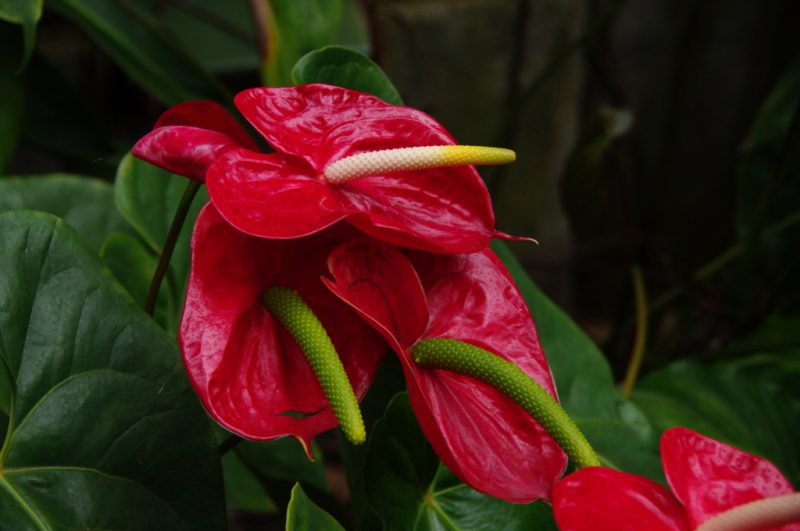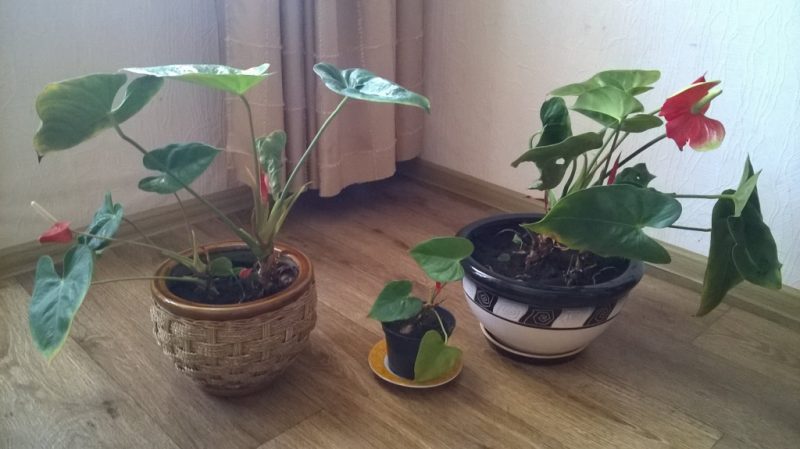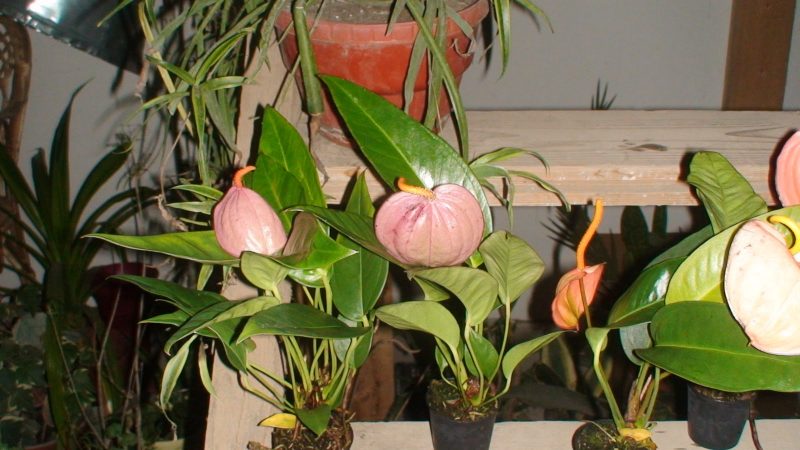Anthurium Scherzer hails from the humid tropics of America. In nature, this flower reaches 1 meter. In indoor conditions, anthuriums do not grow to such an impressive size, but they will certainly please the owners with original flowering.
Material Content:
Anthurium Scherzer: types and varieties
Anthurium Scherzer, perhaps the most unpretentious of all indoor anthuriums. Currently, many hybrids of this houseplant with different colorings of bedspreads have been bred. There are varieties with strong growth up to 60 cm in height or miniature, only 7 cm high.

The most common among our gardeners are anthuriums with a green veil: Arinos, Smaragd and Unica. Red anthuriums are also popular: Artus, Lybra, Rustica, Solara and Hanna. Varieties with a pink coverlet, such as Lacetti, are also bred.
Scherzer's Mix anthurium is especially fond of, being compact and unpretentious. The height of the plant is not more than 20 cm, and this hybrid is derived on the basis of two other varieties.
Houseplant care at home
Home care for anthuriums is quite simple - the plant is unpretentious, and can even put up with the mistakes of beginner growers.
Location, lighting and temperature
The plant comes from the tropics, and this means that it needs warmth.

- The optimum temperature for growing a flower in the spring and summer is around +22 - 25 degrees.
- In winter, the anthuriums need to lower the temperature to +17 degrees. Coolness in the winter period helps to lay more buds for the next flowering season.
This indoor plant in nature grows under the crowns of trees, and therefore it needs diffused light. Anthurium can even bear the shadow, but the sun's rays are destructive for him. But with a lack of light, a plant may bloom poorly or not bloom at all.
Anthuriums also do not tolerate drafts. The best place for a pot is a western or eastern window.
If the windows of the house are facing south, then you should put a flowerpot away from bright light or shade the flower with a curtain.
Watering and humidity
For anthurium, high humidity is preferable, since in the natural environment it grows in a humid climate. Therefore, the flower is constantly sprayed, and in the summer you need to irrigate the foliage every day. In the cold period, one spraying is sufficient once every 5 to 7 days.

If the room is very dry, you should also spray the air around the flower. It’s great if you can put a pot near the aquarium. Many flower growers next to Anthuriums place containers with plain water to artificially increase humidity. Useful for plants and daily rubbing the leaves with a damp cloth. When spraying, you need to make sure that the drops do not fall on the cobs.
- Anthuriums are watered with settled water at room temperature every three days.
- In winter, watering dramatically reduces and water the flowers only once every 3 weeks.
- Watering should be regular and moderate.
- You can’t fill the bushes too much. Stagnant water can be detrimental to anthurium, as well as a lack of moisture.
Fertilizers and fertilizers
Anthuriums will gratefully accept the introduction of complex fertilizers for indoor flowering plants. It is especially important to feed the flowers in spring, during the period of active growth.
Nutrient formulations are added along with watering every two weeks.

It is very important for anthurium to halve the concentration of fertilizer than indicated in the instructions.
In no case should lime be part of the fertilizer.
Transfer
If the flower has not yet reached the age of five, then it must be transplanted annually. After 5 years, anthurium is transplanted only as necessary in a more spacious pot, so that the roots have more space. It is best to transplant in the spring.

The root system of a plant is fragile and thin roots. Therefore, transplant him with caution. The transplant can be combined with the division of the bush for reproduction.
- Put the pot in which the anthurium grows in a basin with standing water so that the soil accumulates moisture and soaks the roots.
- Then the flower, together with a lump of earth, is carefully removed from the pot, holding the base of the stems with one hand and the pot with the other. Do this with extreme caution and very carefully.
- Be sure to make a drain in the new flowerpot. The drainage layer can be filled up with chipped red brick or river pebbles.
- On top of the drainage, a little fresh soil is poured and a plant is placed in the center of the pot.
- The roots are carefully sprinkled with earth, trying not to leave voids.
- It is recommended to slightly deepen the anthurium into new soil, so that the plant gives new offspring.
- Having sprinkled the bush with earth, it needs to be tamped a little and spilled abundantly with water.
- After transplantation, anthurium should be in a shaded place for a week.
Soil for planting anthurium is made up of:
- 1 part sod;
- 1 part of sheet land;
- 1 part moss;
- 1 part peat.
Reproduction of anthurium Scherzer
Mostly flower growers propagate anthuriums at home by cuttings and dividing the mother bush. It can be propagated by seeds, but it is too long and laborious.
It is interesting:streptocarpus

- For cuttings in the spring from the bush, cuttings are separated from the top with 2 to 3 leaves. You can take side shoots if they have roots.
- The plant is rooted in vermiculite, having built a mini greenhouse for it.
- By autumn, young plants are planted in a permanent place in separate pots.
The division of the bush is also carried out in the spring.
- To do this, the plant is removed from the flowerpot, the roots are freed from the soil, and divided using a sharp knife into several divisions.
- Each dividend must have leaves and roots.
- Delenki immediately planted in a permanent place in a separate pot.
Pest and Disease Control
Indoor anthuriums are prone to rot and pests.

- Due to increased humidity, the plant becomes sick with gray rot. Due to the disease, the leaves are covered with a grayish coating, and this happens due to too frequent and heavy watering. When the first signs of the disease appear, watering is completely stopped until the soil dries in the flowerpot. Then the flower is transplanted into new soil.
- If the room is too dry or the flower is in a draft, then its leaves will begin to curl and dry. In this case, they try to increase the air humidity, and the flowerpot is rearranged to a new place. All dried parts of the flower are removed.
- A very dangerous disease is anthracosis. This disease is transmitted from a diseased flower to a healthy one. First, the leaves begin to dry at the edges, and then die. Fungicides are used to treat Anthracosis. Dilute the preparations according to the instructions. If you do not take action, the flower will die!
Of the pests, anthuriums most often attack aphids and scale insects. When insects appear, the leaves begin to curl, yellow spots appear on them. You can fight insects by treating the leaves with a soapy solution. First, the plant is bathed under a tepid shower, and then each leaf is wiped with a soap solution prepared from ordinary laundry soap.
Spraying with special drugs against insect pests will also help.
But in general, anthurium is a wonderful, unpretentious flower. Bright, juicy and surprisingly positive. Do not deny yourself the pleasure of having such a charming green “pet”, and it will delight you with beautiful flowering for many years.












